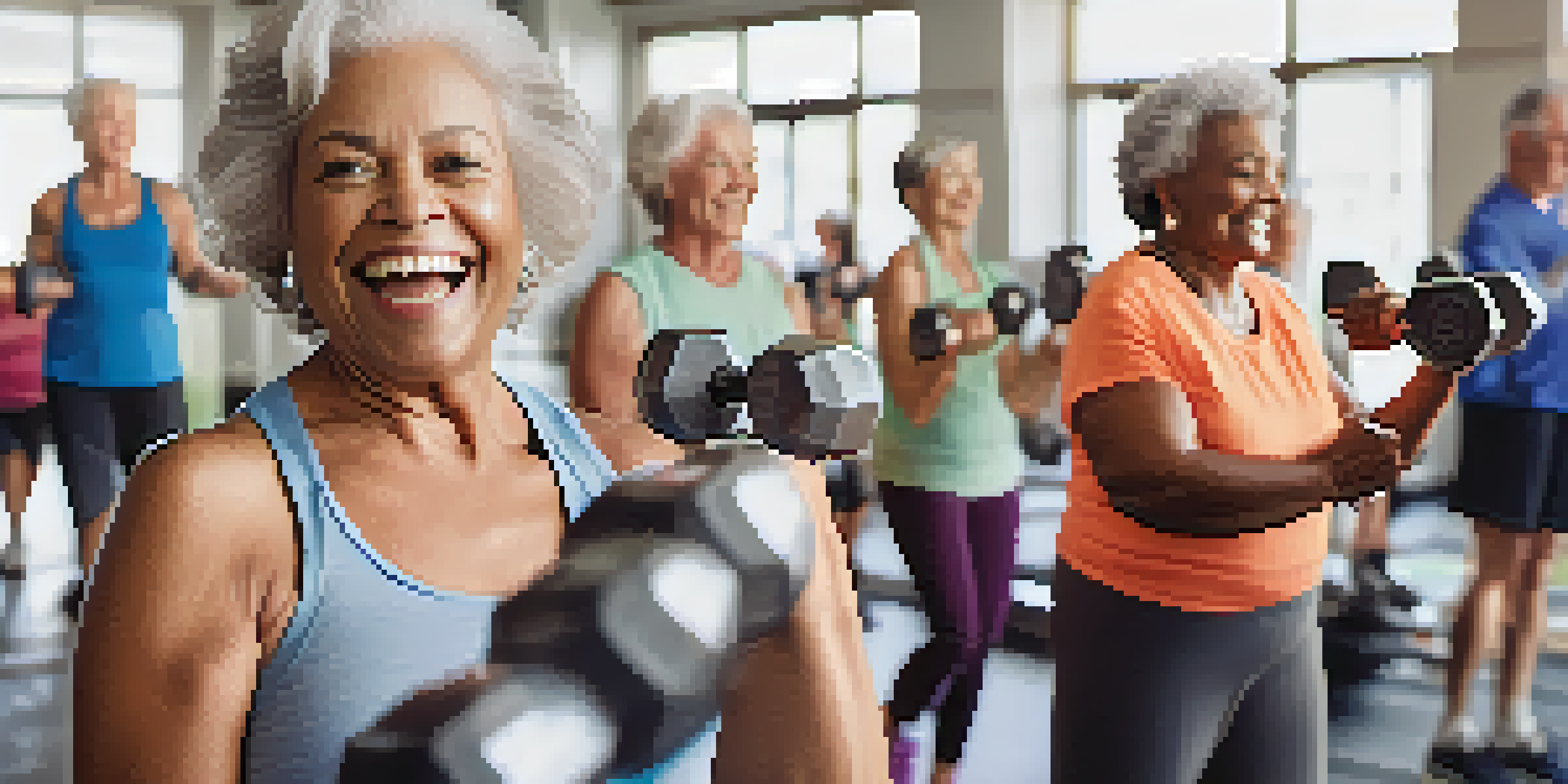Effects of Aging on Muscle Hypertrophy: What You Should Know

What is Muscle Hypertrophy and Why It Matters
Muscle hypertrophy refers to the increase in muscle size, typically achieved through strength training. It's an essential aspect of fitness, affecting not just appearance but also strength and functionality. Understanding muscle hypertrophy is crucial, especially as we age, because it directly impacts our mobility and overall health.
Aging is not lost youth but a new stage of opportunity and strength.
As we engage in activities that promote hypertrophy, our bodies adapt by increasing the size of muscle fibers. This adaptation process is essential for maintaining strength, preventing falls, and supporting daily activities. When we grasp the importance of this process, we can better appreciate the challenges posed by aging.
In essence, muscle hypertrophy is like a protective shield; it helps us stay active and vibrant as we grow older. The more we know about it, the better equipped we are to combat the natural decline in muscle mass that comes with age.
How Aging Affects Muscle Mass and Hypertrophy
As we age, our bodies undergo various changes that can hinder muscle hypertrophy. One major factor is the decrease in hormonal levels, particularly testosterone and growth hormone, which play critical roles in muscle development. This decline can make it more challenging to gain muscle mass or even maintain what we have.

Additionally, aging often leads to a reduction in physical activity, which compounds the problem. Many older adults may find themselves less active due to health concerns or lifestyle changes, further accelerating muscle loss. This reduced activity can result in a cycle where decreased muscle mass leads to less motivation to exercise.
Muscle Hypertrophy Boosts Health
Increasing muscle size through strength training is vital for maintaining strength, mobility, and overall health as we age.
Ultimately, the aging process can feel like a double-edged sword for muscle health. It’s crucial to understand these changes so that we can take proactive steps to mitigate their effects and maintain a strong, healthy body.
The Role of Nutrition in Muscle Hypertrophy with Age
Nutrition plays a pivotal role in muscle hypertrophy, especially as we age. A diet rich in protein is essential for muscle repair and growth, but many older adults do not consume enough protein. This deficiency can hinder their ability to build muscle effectively, even if they engage in regular strength training.
The greatest wealth is health.
Moreover, other nutrients like vitamins D and B12, along with minerals such as calcium, are crucial for muscle health. These nutrients help maintain bone density and support overall muscle function. By focusing on a balanced diet, older adults can better support their muscle-building efforts.
In summary, proper nutrition acts as the fuel for muscle hypertrophy, especially in the aging population. Making conscious dietary choices can significantly enhance muscle growth and help counteract the effects of aging.
Exercise: The Key to Maintaining Muscle Hypertrophy
Regular exercise is essential for maintaining muscle hypertrophy, particularly as we age. Engaging in strength training exercises can stimulate muscle growth and counteract the natural decline in muscle mass. It's like giving your muscles a workout wake-up call, encouraging them to grow and adapt.
Incorporating a variety of exercises, such as resistance training and aerobic activities, can provide a comprehensive approach to fitness. This variety not only helps build muscle but also improves cardiovascular health and overall well-being. It's a holistic way to maintain strength and vitality.
Nutrition Fuels Muscle Growth
A balanced diet rich in protein and essential nutrients is crucial for older adults to effectively support muscle repair and growth.
Ultimately, the key takeaway is that staying active is non-negotiable for preserving muscle hypertrophy as we age. By committing to regular exercise, we can significantly improve our quality of life and maintain our independence.
The Importance of Recovery for Older Adults
Recovery is just as important as the workout itself, especially for older adults. After intense exercise, muscles need time to repair and grow stronger. Without adequate recovery, the risk of injury increases, and progress can stall, making it essential to prioritize rest.
Aging bodies often take longer to recover due to slower metabolic rates and hormonal changes. This means older adults may need to adjust their workout routines to allow for more recovery time. Listening to your body and recognizing when to rest can help prevent overtraining and ensure continued progress.
In conclusion, recovery is a crucial component of the muscle-building process for older adults. By respecting the need for rest, we can enhance our strength and resilience over time.
Addressing Psychological Barriers to Muscle Hypertrophy
Psychological factors can greatly influence muscle hypertrophy, especially in older adults. Many may feel discouraged by age-related changes or previous injuries, leading to a lack of motivation to exercise. It's essential to recognize and address these mental barriers to foster a more positive outlook on fitness.
Building a supportive environment, whether through workout partners or community classes, can enhance motivation and commitment. Sharing experiences and celebrating small victories can create a sense of belonging and drive. This social aspect is often overlooked but plays a vital role in maintaining an active lifestyle.
Exercise and Recovery Matter
Regular strength training and adequate recovery time are essential for preserving muscle hypertrophy and improving quality of life in older adults.
Ultimately, addressing psychological barriers is just as crucial as physical training. By fostering a positive mindset, older adults can embrace their fitness journeys and achieve their muscle hypertrophy goals.
Future Directions in Research on Aging and Muscle Hypertrophy
Research on aging and muscle hypertrophy is evolving rapidly, opening new avenues for understanding how to optimize muscle health. Studies are increasingly focusing on the role of genetics, nutrition, and exercise regimens tailored specifically for older adults. This focus aims to create more effective strategies for combating muscle loss with age.
Emerging research is also exploring innovative supplements and therapies that may enhance muscle growth in older populations. These advancements hold promise for improving the quality of life for many seniors, allowing them to maintain their independence and vitality.

In summary, the future of research in this field looks bright, with the potential to revolutionize how we approach muscle health as we age. Staying informed about these developments can empower us to make better choices for our fitness journeys.